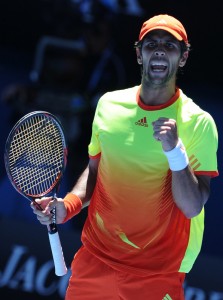Sao Paulo, Second Round
(3) Verdasco d. Marti, 6/4 6/7 7/5
Fernando Verdasco, in cahoots with Rafael Nadal, last year produced what was by broad consensus the worst tennis match of 2011, at the Cincinnati Masters. They are compatriots but they aren’t friends, yet they set aside their mutual antipathy to prolong a merely tedious encounter into a three and a half hour epic of suck.
Although nominally a best-of-three match, it sent a clear warning that not only should woman be excused from playing best-of-five matches at majors, quite a few of the men should be debarred from doing so, as well.  One’s heart quailed at the thought of two more sets. It was also a clear reminder that many players who share a nationality also submit to an informal hierarchy. As the match entered a third tiebreaker, it became obvious that there was no depth to which Nadal could sink that Verdasco could not exceed, until their race to the bottom reached the silt, muck and abandoned car bodies at the bottom of the mire. It turned out that Nadal can no more lose to Verdasco than Djokovic can lose to Troicki, or Federer to Wawrinka.
One’s heart quailed at the thought of two more sets. It was also a clear reminder that many players who share a nationality also submit to an informal hierarchy. As the match entered a third tiebreaker, it became obvious that there was no depth to which Nadal could sink that Verdasco could not exceed, until their race to the bottom reached the silt, muck and abandoned car bodies at the bottom of the mire. It turned out that Nadal can no more lose to Verdasco than Djokovic can lose to Troicki, or Federer to Wawrinka.
There are many things a match must have in order to rank among the very worst. In some respects, the worst matches are simply inversions of the best, those respects being the quality of the play and desperation of each player’s endeavour. In others however, the worst matches share qualities with the finest, such as the resplendence of the occasion – poor quality is only magnified by the big stage – or through sheer length. However, regarding length, there is subtle point to be made. The is a real risk that a poor quality match, once it extends past 6/6 in the fifth, will gain a certain cachet, and thereby attain grandeur in spite of the quality of play. Clement and Santoro proved this some years ago at Roland Garros. Notwithstanding the odd execrable four-setter, it seems generally to be the case that the worst matches are senselessly long best-of-three setters. Or worst-of-three, as it were.
Any survey Verdasco’s career conducted with less than total sympathy demonstrates his proven mastery of the worst-of-three format. Aficionados will recall his loss to Soderling in Rome last year, when he blew three match points, and the match, in a flurry of double faults. From memory, a bug also flew into his eye, and the lights went out. His sobriquet – Fiasco – was not earned ironically.
Today in Sao Paulo an early yet firm frontrunner for worst match of 2012 emerged, and Verdasco of course featured. Again the match was against a countryman, but, for a wonder, it was Verdasco that emerged the victor. Perhaps ‘victor’ is a bit strong. Let’s just say he emerged as the guy who didn’t lose, struggle though he did. Verdasco was surely as puzzled as everyone else by this outcome, but it was a case of the master being outdone by a true prodigy. A star is born, and his name is Javier Martin.
Fans of mind-searing, scrotum-tightening choking must have caught their collective breaths, stricken with wonderment. Verdasco – the undisputed master in this area – was a helpless onlooker as twenty-year-old Marti trumped his elder compatriot’s efforts to lose at every turn. Verdasco, serving at 2/5 0-40 in the final set – once again he had deployed the double-fault lavishly – surely imagined he had found the bottom. Marti, equipped for the long haul, never allowed his inexperience to get the better of him. Squaring his shoulders, he actually burrowed deeper, discovering a hidden, decade-old cache of medical waste below the swamp-bed. From triple-match point up, Marti won barely three or four points in the next five games. Now that’s how it’s done.
Verdasco must have felt terribly old, as though the game was passing him by. This is what choking will look like in the future. How can he hope to compete? However, in a way, he should feel complimented, for imitation is the highest form of flattery. Marti has clearly studied his opponent at considerable length. Verdasco’s influence was subtle and yet pervasive, evident in the sudden torrent of errors from the forehand, or the way Marti saved his final double fault for a key moment. One way or another, the legacy will live on.

4 Responses to Worst-of-Three